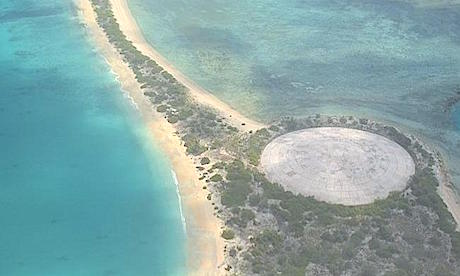Enewetak Atoll, better known as Bikini Atoll, is home to the Runit concrete dome.
It was constructed in 1979 to temporarily store nuclear waste produced from nuclear testing by the United States military during the Cold War.
Residents have expressed concerns about cracks which are slowly developing in the dome’s concrete surface.
The US Department of Energy insists the cracks are cosmetic, a result of drying and shrinking of the half-submerged dome, but there are plans for repairs.
Radio New Zealand’s correspondent Giff Johnson has also expressed concern that the atoll may have been washed over with radioactive waste, after the island was hit by Typhoon Nangka earlier this month.
There are fears that the storm may have churned up lagoon sediment which is laced with nuclear waste.
“Did this stir up a lot of the plutonium and radioactive waste that’s in the sediment, because actually what is more radioactive than what’s in the dome is what’s in the lagoon sediment.”
In total, 67 nuclear and atmospheric bombs were detonated on Enewetak and Bikini between 1946 and 1958 – an explosive yield equivalent to 1.6 Hiroshima bombs detonated every day over the course of 12 years.
The detonations blanketed the islands with irradiated debris, including Plutonium-239, the fissile isotope used in nuclear warheads, which has a half-life of 24,000 years.
The Vatican has long opposed nuclear weapons, but Pope Francis is making the cause one of the top diplomatic priorities.
Source
Additional reading- Listen to interview: Marshallese fear radioactive waste impact following storm
- US official says Church stand on nuclear weapons has aided disarmament
News category: Asia Pacific.




